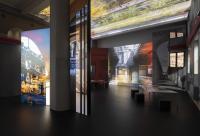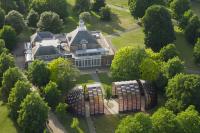Überseeinsel
Bremen, Duitsland
Now that Kellogg’s has departed, the Überseeinsel (Overseas Island) is being built in Bremen on a peninsula site of about 41 hectares between the River Weser and the Europahafen. It links the Weser with the harbour basin, living with working, and the past with the future. Excellent location and historical substance underpin a distinctive, water-oriented district with open-air spaces and attractions for the entire city. Socially and functionally mixed neighbourhoods directly adjoining the Weser round off the precious building stock and line the inner-city riverside promenade that is prolonged to stretch to the very end of the peninsula.
What underpins the Überseeinsel’s urban sustainability is appreciation of the rich qualities and opportunities offered by what is already there, and of its emotional significance for urban society. So, in terms of ‘as found’ (Alison and Peter Smithson), it is therefore a matter not so much of building a new district as of continuing to build upon a geological-topographical and industrial heritage in changed circumstances—different ways of life, new aspirations, and altered attitudes to mobility, plus a growing sense of responsibility for the climate. Hence, the city is seen as a palimpsest, a territory always needing to be recycled (André Corboz), to which new layers are added without obliterating the historical traces.
Essentially, the Überseeinsel peninsula is defined by the linear ‘contour’ of the Europahafen with its long, monumental sheds, and by a varied riverbank frontage along the Weser, rhythmically punctuated by the large masses of former industrial buildings. Between these two flanks lies the infrastructural backbone, a railway line with a characteristic curve. The urban development structure picks up these traces of former industrial use, incorporates them into its scheme and district formation, and connects the two waterfronts by means of green links that ‘perpetuate’ the existing wilder areas. The river and the flat topography are prerequisites for shifting traffic movement in the area towards walking, cycling, and even innovative waterborne traffic.
Existing buildings will be preserved and converted as far as possible. Along with the sheds by the harbour basin (which will continue in commercial use), the Kellogg silo, the Reishalle, and the former Kellogg’s production building No 25 provide distinctive foci and anchor points for new public uses, commerce, and private life. Interpretation of the site ‘as found’, and the improvisation this requires, opens up opportunities for new forms of living, and new creative and social initiatives. In contrast to an immaculately planned city, a variety of unforeseen activities and actors can be accommodated, something that is vital to urban sustainability.
Typologically, the districts draw their compactness from the scale of Bremen. The new small scale, the social mixing, and the hybrid buildings are all references to the city, as also is the reinterpretation and updating of the ‘Bremer Haus’—for example, as a stacked row house.
The framework plan was developed in conjunction with a process of broad involvement by the public, resident businesses, and politicians. Step by step, the existing building stock will be upgraded and converted, interim uses will be made permanent, and concepts prepared for the coexistence of commercial uses and new forms of living.
Award:
Polis Award 2024 – Urban land recycling (1st prize)
- Architecten
- SMAQ
- Locatie
- Bremen, Duitsland
- Jaar
- 2018-2030
- Klant
- Freie Hansestadt Bremen, Überseeinsel GmbH
- Team
- Sabine Müller, Andreas Quednau, Julia Streletzki, Alexandre Berianidze, Sebastian Pitoni, Sofie Vaasen, Ksenia Chernobrovtseva, Martina Rondini, Anne Sofie Solberg
- Landscape architect
- Man Made Land
- Architect
- gruppeomp
- Landscape architect
- nsp
- Traffic enginieer
- Argus










